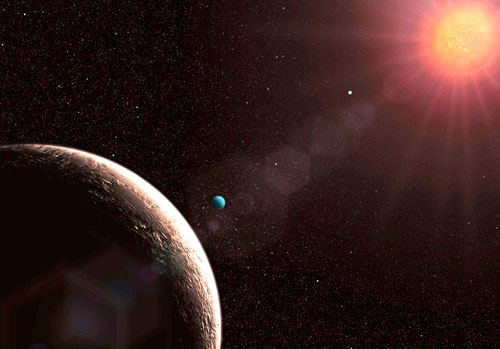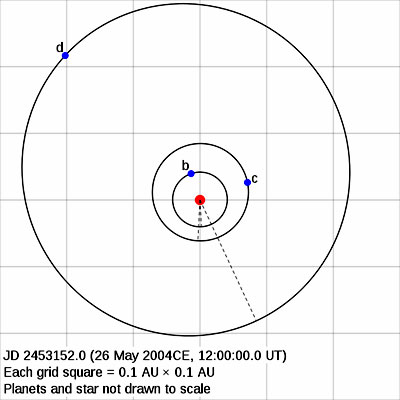|

by
Thomas H. Maugh II
April 22, 2009
from
LATimes Website
|
Associated Press Science Writer Seth Borenstein contributed to this report from Washington.
Both orbit the same star, 20
light-years from Earth, called Gliese 581.
The larger of the two orbits in the
'habitable zone,' and could have oceans. |
After locating more than 340 planets orbiting other stars,
astronomers have identified two that are the most similar to Earth
so far.
The most recently discovered one is almost twice as large as Earth,
making it the smallest exoplanet - for extra-solar planet - found
to date. The second one was found in 2007, but new observations have
shown that it is the only exoplanet to date that orbits its star in
the so-called habitable zone, where water remains a liquid.
Thus, it
is the only exoplanet discovered that is likely to have oceans.

An illustration shows
two exoplanets,
Gliese 581e in
the left foreground and Gliese 581d just to its right,
orbiting a star that
is 20 light-years from Earth.
Intriguingly, both orbit the same star,
a dwarf 20 light-years from
Earth called Gliese 581, European researchers said Tuesday.
The identification of the small planet,
"is a remarkable discovery
and bodes well for our eventual discovery of a true Earth-like,
habitable planet," astronomer Alan Boss of the Carnegie Institution
of Washington wrote in an e-mail.
"It is the most exciting discovery in exoplanets so far," added
astronomer Geoffrey W. Marcy of UC Berkeley via e-mail. "It shows
that nature makes such small planets, probably in large numbers."
The small planet is the fourth discovered circling Gliese 581 by a
team of astronomers working with the European Southern Observatory's
3.6-meter telescope at La Silla, Chile.
They identified the planets
by detecting and analyzing slight wobbles in the star's path as the
planets orbit it.
The small planet, called Gliese 581e, has an estimated mass equal
to 1.9 Earths and orbits its sun every 3.15 days, the team reported
at an astronomical meeting at the University of Hertfordshire in
Britain.
Because it is so close to Gliese 581, it is blisteringly
hot and any gases or liquids that it might have carried have long
since dissipated, leaving only uninhabitable rock.
In February, French astronomers said they had discovered an even
smaller planet, called CoRoT-Exo-7b, that has an estimated mass
equal to 1.7 Earths, circling a different star. But experts said the
data for Gliese 581e is more convincing.
The other three planets in the Gliese system have masses of 16, five
and seven Earths. The one with a mass of seven Earths, called Gliese
581d, was initially thought to have an orbital period of 80 days,
which would put it just on the outer edge of the habitable zone.
Recent refinements of the data, however, show that it has an orbit
of only 66.8 days, which places it well within the habitable zone,
astronomer Stephane Udry of Geneva University told the meeting.
Because of its distance from Gliese 581, moreover, it must have a
significant amount of water and other gases, he added. It could have
oceans thousands of meters deep, he said.

The Gliese 581
planetary system orbits,
prior to the
discovery of Gliese 581e
The team is continuing to monitor Gliese 581 in hopes that the
orbital planes of the planets will bring them between the star and
Earth, which will allow astronomers to learn more about their
composition.
Scientists Discover a Nearly Earth-Sized Planet
by Jennifer Quinn
Associated Press Writer
April 21, 2009
from
YahooNews Website
HATFIELD, England
In the search for
Earth-like planets, astronomers zeroed in Tuesday on two places that
look awfully familiar to home. One is close to the right size.
The other is in the right place.
European researchers said they not only found the smallest exoplanet
ever, called Gliese 581e, but realized that a neighboring
planet discovered earlier, Gliese 581d, was in the prime
habitable zone for potential life.
"The Holy Grail of current exoplanet
research is the detection of a rocky, Earth-like planet in the
'habitable zone,'" said Michel Mayor, an astrophysicist at
Geneva University in Switzerland.
An American expert called the discovery
of the tiny planet "extraordinary."
Gliese 581e is only 1.9 times the size of Earth - while previous
planets found outside our solar system are closer to the size of
massive Jupiter, which NASA says could swallow more than 1,000
Earths.
Gliese 581e sits close to the nearest star, making it too hot to
support life. Still, Mayor said its discovery in a solar system 20½
light years away from Earth is a "good example that we are
progressing in the detection of Earth-like planets."
Scientists also discovered that the orbit of planet Gliese 581d,
which was found in 2007, was located within the "habitable zone"
- a
region around a sun-like star that would allow water to be liquid on
the planet's surface, Mayor said.
He spoke at a news conference Tuesday at the University of
Hertfordshire during the European Week of Astronomy and Space
Science.
Gliese 581d is probably too large to be made only of rocky material,
fellow astronomer and team member Stephane Udry said, adding
it was possible the planet had a "large and deep" ocean.
"It is the first serious
'water-world' candidate," Udry said.
Mayor's main planet-hunting competitor,
Geoff Marcy of the University of California, Berkeley, praised the
find of Gliese 581e as "the most exciting discovery" so far of exoplanets
- planets outside our solar system.
"This discovery is absolutely
extraordinary," Marcy told The Associated Press by e-mail,
calling the discoveries a significant step in the search for
Earth-like planets.
While Gliese 581e is too hot for life,
"it shows that nature makes such
small planets, probably in large numbers," Marcy commented.
"Surely the galaxy contains tens of billions of planets like the
small, Earth-mass one announced here."
Nearly 350 planets have been found
outside our solar system, but so far nearly every one of them was
found to be extremely unlikely to harbor life.
Most were too close or too far from their sun, making them too hot
or too cold for life. Others were too big and likely to be
uninhabitable gas giants like Jupiter. Those that are too small are
highly difficult to detect in the first place.
Both Gliese 581d and Gliese 581e are located in constellation Libra
and orbit around Gliese 581.
Like other planets circling that star - scientists have discovered
four so far - Gliese 581e was found using the European Southern
Observatory's telescope in La Silla, Chile.
The telescope has a special instrument which splits light to find
wobbles in different wavelengths. Those wobbles can reveal the
existence of other worlds.
"It is great work and shows the
potential of this detection method," said Lisa Kaltenegger, an
astronomer at the Harvard-Smithsonian Center for Astrophysics.
|


